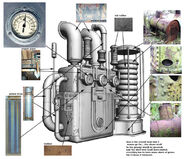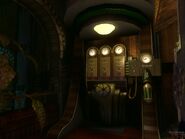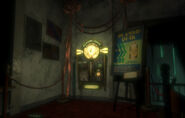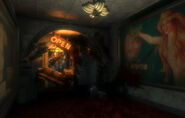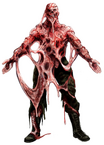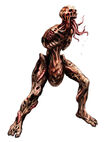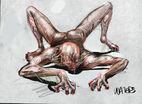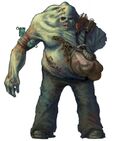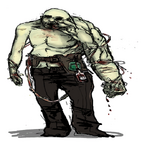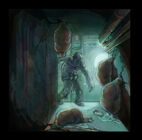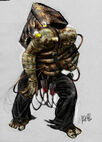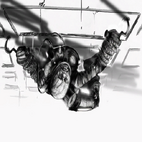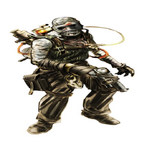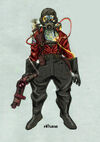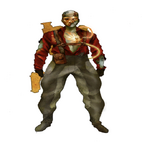
|
"The slugs alone could not provide enough ADAM for serious work. But combined with the host...
now we have something." - Brigid Tenenbaum This article, or section of an article, is a stub.
It is too short to provide more than rudimentary information about a subject. Would you kindly help this wiki by expanding it? |
Before its final version, BioShock was submitted with numerous ideas from its developers, 2K Games. This article's purpose is to reveal all recorded content that did not make it to the game, or that was modified beforehand. However, since the following elements were removed or unused on purpose from the final version of the game, they should not be freely considered canon to the game's history nor as an actual part of its universe.
The Original BioShock Pitch
Very early in the development of BioShock a "pitch" was created to gain financial support from development of the game. This pitch gives a unique look at the concepts, setting and game mechanics first envisioned for BioShock.
Mechanics and Gameplay Elements
A Single Ending
BioShock was originally a game with only one, ambiguous ending. Levine remarked, "There are a million different things you can do in every combat; you can play it a million different ways. Looking into the future for the franchise, that's something I want to [figure out], that by the time you get to the ending of that choice path, you have a sense of your impact on the world through lots of little permutations rather than like a giant ending piece, if you follow my meaning." The two endings were added late in development, when the game publisher requested it.[1][2] [3]
Atmospheric Pressure System
In BioShock, a feature originally existed that would change the local air pressure levels from low, normal, and high parameters.[4] It entailed altering the dynamic lighting and fog effects for each change and adjusting enemy AI animations, vocalizations, appearance, speed, and vulnerabilities. For example, flames would shoot farther under low pressure and bullets were more likely to blow things apart under high pressure.
This was eventually scrapped because it was difficult to visually convey to the player the changes in air pressure and its effects. Notably, the mechanic was reused in the tree-killing scene in Arcadia.
Research Machine
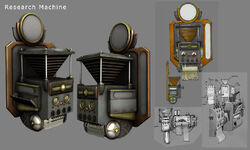
The Research Machine.
This appears to be a device used to obtain Research Rewards. Similar to other vending machines, an item is exchanged for a service; in this case, film pictures are developed to gain valuable research information. In the final game, the machine is absent and the process is streamlined. Jack need only take a picture with the Research Camera to earn Research Rewards.
Strings from the game files indicate that developing photos would require money and the machine could even be hacked to reduce the cost.[5]
The Research Machine was designed by Mauricio Tejerina.
Dual Wield
Dual wielding, meaning that the player could use both their weapon and their Plasmid at the same time, was intended for BioShock, but was cut last minute for unknown reasons.[6]
Levels
Before the Art-Deco style of Rapture was finalized, the different areas of the city were called Decks. For example, Fort Frolic was the Recreational Deck, and Arcadia was the Hydroponics Deck, which both were names for levels in System Shock 2.
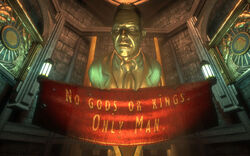
The promotional image.
The Lighthouse
BioShock: The Collection
A promotional image for BioShock: The Collection, featuring the remastered version of BioShock, shows a different design for the Andrew Ryan statue in the Lighthouse lobby, than what is seen in the final version.
Welcome Center
Kashmir Restaurant
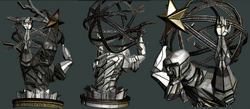
The early model, by Scott Sinclair.
The Restaurant has a blocked door leading to the Footlight Theater that was supposed to have a lot more bodies than the two seen in the game in front of the door, resembling everyone trying to get out at the same time and trampling each other during the attack on New Year's Eve of 1959.[7]
The Atlas statue in the restaurant had a slightly different model than what can be seen in-game.
The restaurant's interior was originally slightly different from what is seen in-game, visible in the gallery below.
Footlight Theater
The Footlight Theater was not originally a theater at all, but merely the burnt out shell of a building. Since the game developers had so many assets from the Fort Frolic level it was decided to change the room into a small theater space, to give the Big Daddy and Little Sister a literal theatrical introduction.[8]
This was the place where the player would originally get the Revolver, from the Thuggish Splicer attacked by the Big Daddy, but was moved to the Kashmir Restaurant's entrance so the player would get a gun earlier.[7]
Medical Pavilion
Early promotional images of the Medical Pavilion show it being full of makeshift barricades and barbed wire, making it appear much more like a literal war zone. The Pavilion's Metro Station was also originally located in a separate building and connected to the medical center via glass tunnel.
A "Tenenbaum, B. PhD." plaque is found in the game files for the level, which was not used in the final version of the game.[9] This indicates that Brigid Tenenbaum did have an office in the Medical Pavilion at one point during development.
Arcadia
Players will notice a collapsed passageway at the end of Arcadia Glens. This was originally another way to the Langford Research Laboratories, but it was changed for unknown reasons. The park would have had two entrances to the Farmer's Market, the one at Tree Farm, which remained in-game, and another in the Rolling Hills which would have led directly into the wine cellar of Worley Winery.[10]
Also, earlier versions of this level had Ryan killing the flora in Arcadia in stages as the player progressed to each new area.[10]
Farmer's Market
The Farmer's Market was first built twice as large as its final version, with two symmetrical halves and long corridors for the various stalls. The level ultimately had to be cut in half for navigational and production reasons, and the market's corridors were separated using doorways.[10] The Rapture Metro Station found in Arcadia was first placed in the southeast corner of the Farmer's Market, where a Gene-Bank can now be found. It was moved to the Rolling Hills when the developers decided a trek back after healing the forest was boring and redundant.[10] The hanging corpses found in the crawlspace in one of the fruit stalls in the Main Market were leftovers from an idea of a serial killer loose in Rapture during the fall.[10]
Fort Frolic
Rapture Zoo
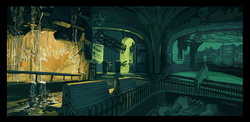
Concept art of the Zoo.
The Rapture Zoo was an area that was intended to be included in BioShock as a part of Fort Frolic. Multiple interviews with developers of the game mention that this was a level that was ultimately cut fairly far along in the design process due to time constraints, and they indicate that it was one of the things they most regretted having to cut. The only known piece of information about this level is that it would have featured an elephant.
Ferris Wheel
A Ferris Wheel was supposed to be included somewhere in the map, but much like the Rapture Zoo, the wheel was cut far in the process. Luckily, it is included in the downloadable content: The Challenge Rooms.[11]
Characters
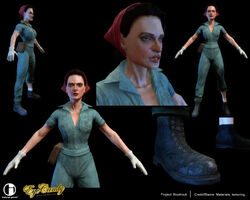
The Emily model. (AKA Beta Brigid Tenenbaum's model)
Brigid Tenenbaum
Brigid Tenenbaum originally had her own unique character model called "Emily." The early character model had two forms, one appeared to be a young woman in a mechanic's jumpsuit (Seen picture to right) similar to the Rosebud while the other form was that of an older woman in a more distressed jumpsuit. This model was cut and replaced with a slightly touched up Lady Smith model kept in the shadows. Brigid Tenenbaum was actually intended to have a unique character model in BioShock, but was left without one for the sole reason that there was no room in the budget.[12]
Captain Cal Franklin
Audio files (streams_0_audio.fsb & Vo_0_Planedive) holds a few unused lines spoken by Captain Cal Franklin, the pilot of Apollo Air Flight DF-0301. The full sequence including Jack's unique phrase without the missing part (in the game's English dubbed version only) and a stewardess imply a different opening where the plane crashed by accident instead of being hijacked. The lines are as follows:[13][verification overdue: remove]
Jack: When mom and dad put me on that plane to visit my cousins in England, they told me, 'Son, you're special. You were born to do great things.' You know what? They were right.
Stewardess: Excuse me sir, excuse me… Excuse me sir, your tray table, would you kindly-
Captain: Ladies and gentlemen, this is Captain Cal Franklin, it seems we have a bit of a problem…
Captain: We're losing altitude really fast… looks like oversped number one and three… there's smoke coming out of the panel and… I got it…PULL UP!!! PULL UP!!! I got it…PULL UP!!!
Julie Langford
Julie Langford was originally supposed to be a male: Holden Langford, but it was cut far in the progress. Ken Levine stated that they didn't have many female characters in the game, and so they made the change.[7]
The only reference to this in-game is a mistake made by the developers: if the player looks at the sign in the reception area at the entrance to Langford Research Laboratories in Arcadia, the subtitled text will read "Professor Holden Langford Research Laboratories."
Sander Cohen
Early footage of BioShock shows an alternate audio diary portrait for Cohen. It was also used on an early poster for Why Even Ask?
Enemies
The Gatherer
Before the Little Sisters were chosen to be the ADAM producers and gatherers in Rapture, many other designs were talked about and drawn up. The first idea was for the actual Sea Slugs themselves to be the gatherers, however this idea was scrapped as the player would not feel empathy for the slugs. Other designs included frogs, chipmunks, crabs, monkeys and even a crippled dog. The idea of using little girls was picked because the player would easily feel sorry for them and want to save them, making harvesting a much tougher choice.[14] The icons displayed on screen when the player is given the choice the rescue or harvest the Little Sister, were originally an angel for rescue and a devil for harvest. This was cut by Ken Levine, as he wanted to leave the morality of the choice ambiguous.[15] The Little Sister's eyes were at one point glowing completely red instead of yellow.[16]
Slow-Pro

Research Icon for Slow-Pro.
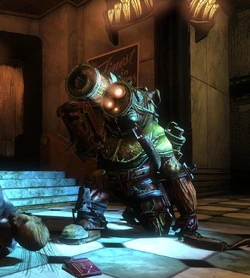
A Slow-Pro in early gameplay.
- Main article: Slow-Pro
The Slow-Pro, dubbed "SlowProFum" or "Slow Pro FUM" by the development team, was a model of Big Daddy cut from BioShock. Standing for "slow-moving, projectile-shooting, f'ed-up-melee", this Big Daddy was intended as a slow, ranged type that would center itself and kneel to fire a heavy projectile at enemies via a large arm-mounted cannon. However he was cut out in late devolopment due to limitations in file space and storage.
It was also planned to get research points from Slow-Pro like other enemies in some point of devolopment. His research icon can been seen in BioShock: Breaking the Mold. This Big Daddy was modified and featured in BioShock 2 as the Rumbler, where the player can now get research points from him.
Savants
Savants were genetically engineered enemies/bosses in an early version of BioShock. The Savants were essentially "heads in jars" that was in control of the city and effect different aspects of each level in the game. Each level had its own Savant that would have to be defeated, two of which were named Themis and Prometheus. The developers felt that there where too many [Savant] characters that didn't make any sense and that interactions/fighting a head in a jar was not fun or logical.[17][18]
Aggressors
During the early stages of BioShock's development, the game's main enemies, who at this point were called Aggressors, had purposefully mutated themselves in order to be able to utilize better weapons and become stronger foes. As their concepts developed, the team decided that the enemies became creepier as they became more human. Eventually this realization, along with the change in Rapture's design and purpose, lead to the Splicers we see in the final game. Though removed from the final game, many Aggressor models appear as statues in BioShock Ultimate Rapture Edition, in the Museum of Orphaned Concepts.
Stitchy
"Stitchy," also known as the Ranged Aggressor, was the first Splicer created. Stitchy was fully functional in-game with kinematics, hit reaction, voice-over and was used in many early demos. Stitchy is a very muscled character, missing an arm and carrying a Shotgun in the other. He wears only pants, has a tumor growing out from his head and what appears to be intestines hanging out from his stomach. Lead artist Shawn Robertson labeled him as "Probably the worst abortion that Irrational has ever made."
Yam Hand
The Yam Hand was an early concept for a splicer from a time period when disproportional limbs were being considered. Of special note is the misshapen head which it's creator Robb Waters liked since "It kind of made you wonder what the heck was going on under that dingy burlap sack." Given the lack of weapon, this splicer may have resorted to melee attacks.
Missing Link
The "missing link" splicer is the last of the more monstrous splicers and points towards the development of the more human Splicers seen in the game. The official name seems to be "Rifleman". As with some other designs of this time, this splicer has a device on his back that is pumping fluid into him. Unlike most other splicers in development at the time his clothes are mostly intact and he does not have disproportionate limbs.
Hooker
The "Hooker" is an early character model for the Spider Splicer that was created before enemies for BioShock were determined. The model is a bald female with hooks attached to her arms and legs, giving her the ability to climb on walls and ceilings. She was eventually developed in to the Baby Jane Splicer model.
Grenadier Splicer
The "Grenadier" is what would ultimately have similar functions as the Nitro Splicer. This large gray model spliced to carry giant grenades to throw at the player. He has a backpack and a messenger bag for the grenades and additional smaller bags attached to his pants. He has a strange black tool sticking out from his chest and bandages covering the majority of his arms and face.
Splicer Models
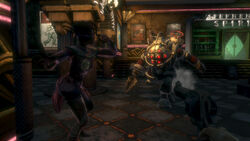
An early look at Fort Frolic.
Baby Jane
The Baby Jane Splicer has been seen in some prelaunch images of BioShock wearing both a pink dress and a white fabric rose. Neither of these cosmetic varitations are seen in the final version of the game. Her earlier concept designs also show her with medium-length unruly, brunette hair, and more cuts across her face.
Early Character Types
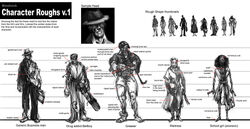
The early concept for the archetypes.
Once it was decided that the Splicers would be more human, early ideas were drawn up of the different types of people who be seen in that era. The designs on the right show five early ideas. A business man (which would eventually evolve into the Breadwinner model) and four others models which never made it past the drawing board, a Bellboy, Greaser, Waitress, and a School Girl.
Ducky
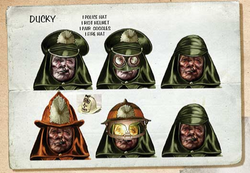
Concept art of Ducky's headgear.
Concept art reveals that various types of headgear were considered for the Splicer model Ducky. In addition to the waterproof hood that all Ducky Splicers wear, a peaked police cap, a Brodie-style helmet listed as "riot gear helmet," a pair of goggles, and a firefighter's hat were proposed. The latter headpiece also suggests that Ducky might've had a fireman orange colored uniform could've expanded Ducky's range of duties to that of a firefighter. Ultimately, only the police officer's hat made it past the drawing board.
Mommy Dearist
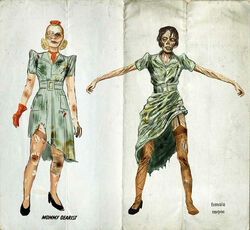
Concept art for the female Splicer.
Concept art from BioShock: Breaking the Mold reveals an illustration of a unique female Splicer labeled Mommy Dearist[19] that does not appear in the final game. She wears a light-teal colored dress accessorized with single orange glove, ascot, and fascinator.
Nothing is known about the character since it was never made, but the design of her dress was used for the many female Corpses seen in the game. Although she doesn't appear in the game, various parts of her design have parallels with the appearance of other Splicers: Lady Smith has a similar 1940's hairstyle and silhouette, one of Toasty's eyes is covered with a heavy gauze bandage, and Baby Jane wears a dress with a dramatically torn hemline. It is perhaps because of these multiple comparable designs between her and other Splicers that this model never made it past the drawing board.
Early Splicer Concept Art
The road to the finalized Splicer design was long and varied. Many monstrous designs were proposed before the game creators finally agreed that a more identifiably human enemy delivered greater horror and pathos than any deformed "creature" could. Many of the Splicer designs were showcased in the Museum of Orphaned Concepts.
Businesses
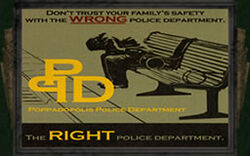
Poppadopolis Police Department
The Poppadopolis Police Department is a subscription police department that operated in pre-war Rapture, only known from a single, unused advertisement in the Strategy guide. In Rapture's objectivist economic conditions, there were many other subscription services, including semi-canon businesses, like Fontaine Fire Fighters. Judging from the poster, there seems to be multiple other subscription police services.
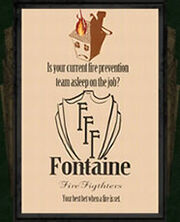
Fontaine Fire Fighters
Fontaine Fire Fighters is a fire department owned by Frank Fontaine, operating in Rapture. The company's policy was swift action in case of a fire emergency. Fontaine Fire Fighters was ultimately cut from the game and thus is a semi-canon business.
Sinclair Spirits
Sinclair Spirits was originally named Stephenson Spirits. This is revealed from the texture file for the sign, as it reads Stephenson_Spirits_Diffuse.tga and from a prelaunch image of Fort Frolic displayed above.[20]
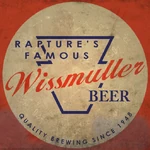
Wissmuller Beer
Advertisements for Weissmuller Beer were intended to be featured in BioShock, which is evident by its appearance in BioShock: Breaking the Mold and on the back of the PlayStation 3 manual for BioShock. The advertisement did however make it into BioShock 2 Multiplayer and The Protector Trials.
Topaz Brand
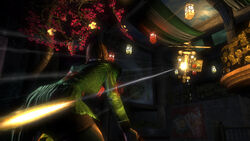
The pre-launch image.
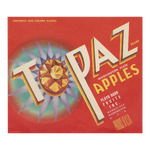
The advertisement.
An advertisement for Topaz Brand apples was seen in a pre-launch promotional screenshot of Arcadia, but was not featured anywhere in the final version of the game. The advertisement is based on the real-world Topaz Brand fruit crate label and doesn't appear to have been altered in any way.
Items
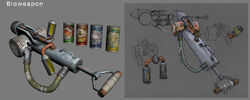
The Bioweapon.
Bioweapon
Fastened from impromptu parts and resembling a pump-action bug sprayer, the Bioweapon can be seen as the precursor to the Chemical Thrower. The device fires chemicals that were eventually integrated into the player's Plasmid abilities. The four Plasmids it was capable of expelling were Insect Swarm, Berserk Toxin, Disease Cloud, and a Generic Repellent.
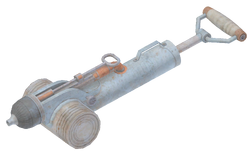
The trimmed down Bioweapon as it appears in the Silverwing Apiary.
Interestingly enough, both the Bioweapon and its ammunition exist in Rapture. A slightly toned-down version of the weapon can be found in the Silverwing Apiary, though it cannot be used in its original function. Cans of "Berserk" can be seen stacked in one of the target practice stands at Rapture's Grand Carnival in the Challenge Rooms stage A Shocking Turn of Events. The Bioweapon was designed by Mauricio Tejerina.
Gatherer Machine
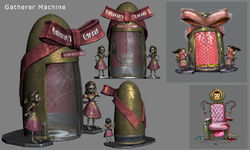
Gatherer Machine.
What appears to be a significantly different version of the Gatherer's Garden was designed by Mauricio Tejerina. Aside from being flanked by the iconic Little Sister statues, the machine more closely resembles a Vita-Chamber than the Plasmid-dispensing vending machines.
Med Hypo
This item was cut at late development but it only appears in audio dairy "Big Night Out" and yet still in game files and only through console commands. However, the Health Hypo was an item of the System Shock game series, and its associated sound has been reused for the EVE Hypo injection sound.
Gene Tonics
Organic Pockets
Organic Pockets was a Gene Tonic that was removed from the final version of the game. It allowed the player to have double the normal capacity for First Aid Kits, and EVE Hypos. This tonic was ultimately removed from the game prior to release, but still can be enabled on the PC version with modification.
Shutdown Expert
Shutdown Expert was a Gene Tonic in BioShock that was removed from the final version of the game. The tonic would have changed the amount of time that Security Cameras and Turrets stay hacked. Since Security Devices in the final game stay hacked permanently, this tonic was dropped. However, it can still be enabled in the PC version of the game through modification, although it will not give any effects.
Plasmids
Aggressor Irritant
Aggressor Irritant is a Plasmid that existed in an early video of BioShock, narrated by Ken Levine, but was ultimately removed from the game. This Plasmid is similar in functions to Enrage and Security Bullseye, but different in that when used on an enemy, it would have caused everyone in the area to attack them.
Parasitic Healing
Parasitic Healing was cut in late development of the game. The Plasmid would have fired an energy bolt at enemies, damaging them and healing the player. As with most other Plasmids, Parasitic Healing would have had three levels of advancement. In addition, certain Spider Splicer variants would have been able to use this Plasmid. These enemies would have appeared in multiple levels, including Point Prometheus and the Proving Grounds, and would have looked the same as regular Spider Splicers.
Sanctuary
This Plasmid was cut in early development. It was to create a bubble to protect the player, intended to be used while hacking, as initially the game did not pause during this time.
Speed Booster
This Plasmid was cut during early development, and only appeared in the first demo. BioShock 2 Multiplayer's Aero Dash has similar functions.
Telekinesis 2
The Telekinesis Plasmid was to have a upgraded version named Telekinesis 2 that was supposed to cause more damage. The sales pitch was: "Mind over matter has never been better, with new, improved Telekinesis! PULLS an object to you, then THROWS it with IMMENSE FORCE."
The Plasmid is featured in BioShock 2.
Teleportation
This Plasmid was cut late in development due to the potential for glitches and skipping important story events. It still appears in an in-game advertisement.
In BioShock 2, the Plasmid shows up as an Easter Egg.
Audio Diaries
- Brigid Tenenbaum - Gatherer's Flu
- J.S. Steinman - Why Two
- Peach Wilkins - Prison Code
- Peach Wilkins - Smuggling is a Crime
- Yi Suchong - Little Sisters and Corpses
Public Address Announcements
See Also
References
- ↑ "Levine: '…opposed to multiple endings'" on Rock Paper Shotgun
- ↑ 2007 interview with Ken Levine on Gamespot archived at web.archive.org
- ↑ 2014 interview with Ken Levine by THE WAYFARING DREAMER [1]
- ↑ Five Cut Features Irrational Games blog
- ↑ From the file Machines.ini: "HackingSuccessFeedbackText="Successfully hacking this station will cause photo upload costs to be lowered."
- ↑ Ken Levine on Twitter
- ↑ 7.0 7.1 7.2 BioShock commentary with Jean-Paul LeBreton
- ↑ Ex-BioShock Dev Shares 'Welcome to Rapture' Secrets - IGN First on YouTube
- ↑ Medical Pavilion Plagues on Imgur
- ↑ 10.0 10.1 10.2 10.3 10.4 "Arcadia Demade", designer commentary by BioShock developer Jean-Paul LeBreton on his blog, vectorpoem.com
- ↑ BioShock: Breaking the Mold
- ↑ BioShock: The Collection - Director's Commentary - Community Theatre
- ↑ BioShock's subtitle text files:
streams_0_audio.fsb&Vo_0_Planedive - ↑ BioShock Making of - Characters on YouTube
- ↑ Q&A: Diving deeper into BioShock's story interview with Ken Levine on GameSpot
- ↑ BioShock Launch Trailer on YouTube
- ↑ BioShock Making of - Evolution on YouTube
- ↑ Designing the Opening Level of Bioshock with Bill Gardner on YouTube
- ↑ The art book in the BioShock iOS app
- ↑ An early look at Fort Frolic


